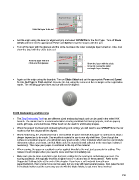Page 218 - KNK Maxx Groove-e with MTC User Manual
P. 218
Hide the layer to be cut
Set the origin using the laser (or alignment pin) and select WYSIWYG for the Cut Type. Turn off Blade
Offset and then set the appropriate Force and Speed. Draw the shapes with the pen.
Turn off the layer with the glasses and the circle, but leave the outer rectangle layer turned on. Also, now
show the layer with the circle to be cut:
Hide the layer with the
circle and the glasses Show the layer with the circle
to be cut. Leave the outer
rectangle layer showing.
Again set the origin using the laser/pin. Turn on Blade Offset and set the appropriate Force and Speed.
Set the Cut Type to Print and Cut. Execute the cut, using the corners of the rectangle as the registration
marks. The resulting gel pen lines and cut will now be aligned:
10.08 Embossing and Scoring
The Zing Embossing Tool has two different sized embossing heads and can be used in the other KNK
models. The smaller one is recommended when scoring cardstock for fold-up projects, such as pop-up
cards, gift bags, and small boxes. Either head can be used for embossing shapes.
When the project involves both embossing/scoring and cutting, you will need to use WYSIWYG for the cut
mode so that the shapes will be aligned.
When embossing, it is recommend that a soft material be place beneath the paper or cardstock to allow a
deeper impression to be made. One excellent material to use is non-slip shelf liner. Even though the
surface is somewhat uneven, you will obtain very good results. Other materials which can be used include
rhinestone rubber, craft foam, and felt. Make sure the material is well adhered to the mat (tape it down, if
necessary). Then tape your paper or cardstock to the top of this material.
When scoring, the paper or cardstock can be applied directly to the mat, just as you do for cutting. This
makes it much simpler when you need to score and then immediately cut.
Make sure you do some tests first to get the best settings for the scoring or embossing you need. For
scoring cardstock, this typically involves a higher force (~150) and two or three passes. Refer to the
Suggested Settings table at the end of this chapter. If you have a soft material beneath your
paper/cardstock, then a lower force can be used, but you may still need several passes. Also raise the tool
in the blade holder seat the same way you do with the blade holder, to get more force invoked.
218


